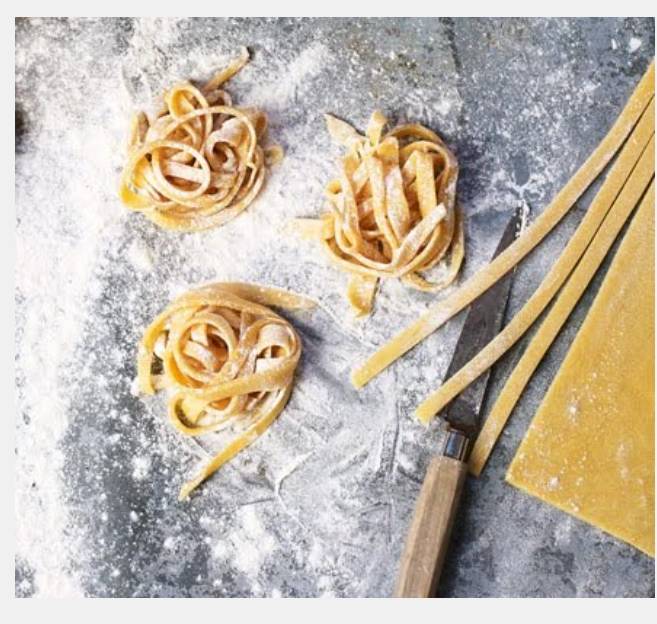What flour do you use for pasta?
There are two types of fresh pasta:
- Egg pasta which is used for lasagne, tagliatelle and filled pastas
- Flour-water pasta that's made from semolina flour (also called durum wheat flour) and used for shapes like or orecchiette and cavatelli
Traditionally, ‘00’ flour is used for egg pasta as it’s high in gluten, which stops the pasta from snapping when rolling out or cutting into strands. This ’00’ flour is wheat flour that has been put through the mill twice, so it's very fine. It has a higher protein count than plain white flour, which is important for the structure of the dough. It can be found in most large supermarkets. You can also make pasta with plain or plain strong flour, but it will be harder to work with. Self-raising flour shouldn’t be used to make pasta as it puffs up when cooked.
See our guide for how to make pasta for more info on pasta shapes and ingredients.
What if my dough is too dry?
You may need to add a touch of water to the dough if it feels too dry. Make the dough with your hands so you can feel the texture. Add 1 tsp water at a time and work it into the dough before adding more.
What if my dough is too wet?
Add a sprinkling of flour under the ball of dough while you’re kneading it on the work surface, adding a little at a time until the dough stops sticking.
How long will fresh pasta last?
Fresh pasta that has been dried out properly will last a week in an airtight container in a cool place. Undried fresh pasta should either be used that day or frozen. Filled pasta should be frozen if not being used straightaway; freeze it on baking sheets and store in freezer bags once solid. Remember: the egg in the pasta is raw, so you need to store it properly.
Can you freeze pasta dough?
Freeze pasta that's been cut into strips in ‘nests’ or cut into lasagne sheets (keep these separated into sheets) and cook from frozen. Fresh, undried pasta is extremely quick cooking; dried and frozen pasta will need another couple of minutes.

How do you make pasta without a machine?
For an egg dough, it’s best to invest in a pasta machine. Of course, the original way to roll pasta is with a rolling pin, but without a lot of practice and a very long rolling pin, it's difficult to get it thin enough and to the right consistency. Flour and water pasta is not rolled into sheets and is easier to make.
For a visual demonstration, watch our video on how to make pasta with a machine.

How to cook fresh pasta
Once you have shaped your pasta, you can cook it straightaway, leave it out to cook later that day or freeze it flat or coiled into nests on flour-dusted trays (freezing pasta can retain the texture better). Pasta can be cooked straight from frozen – allow a few more minutes of cooking time and taste for doneness. How long your homemade fresh pasta will take will depend on the shape it is – start at 1 minute 30 seconds and cook for up to 4 minutes, testing every 30 seconds



